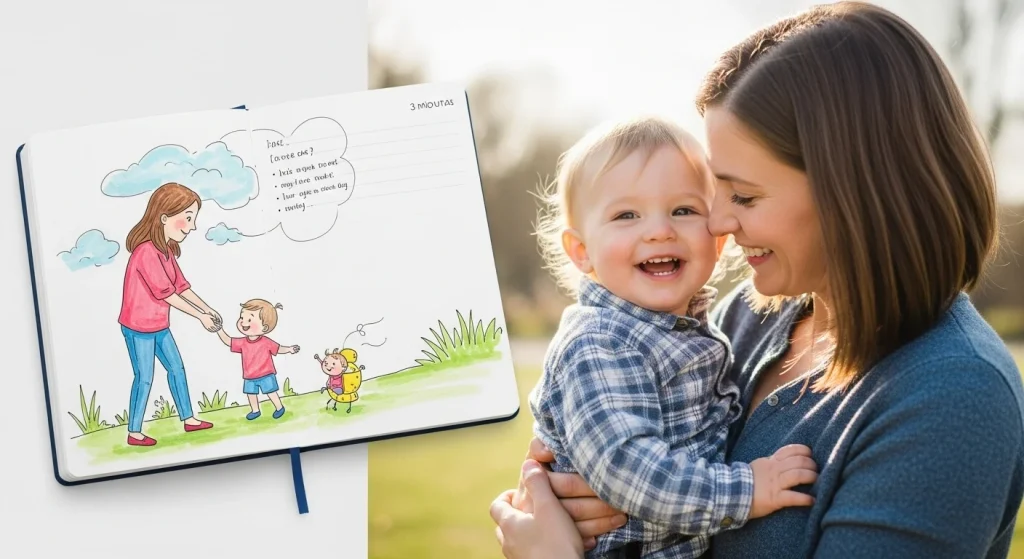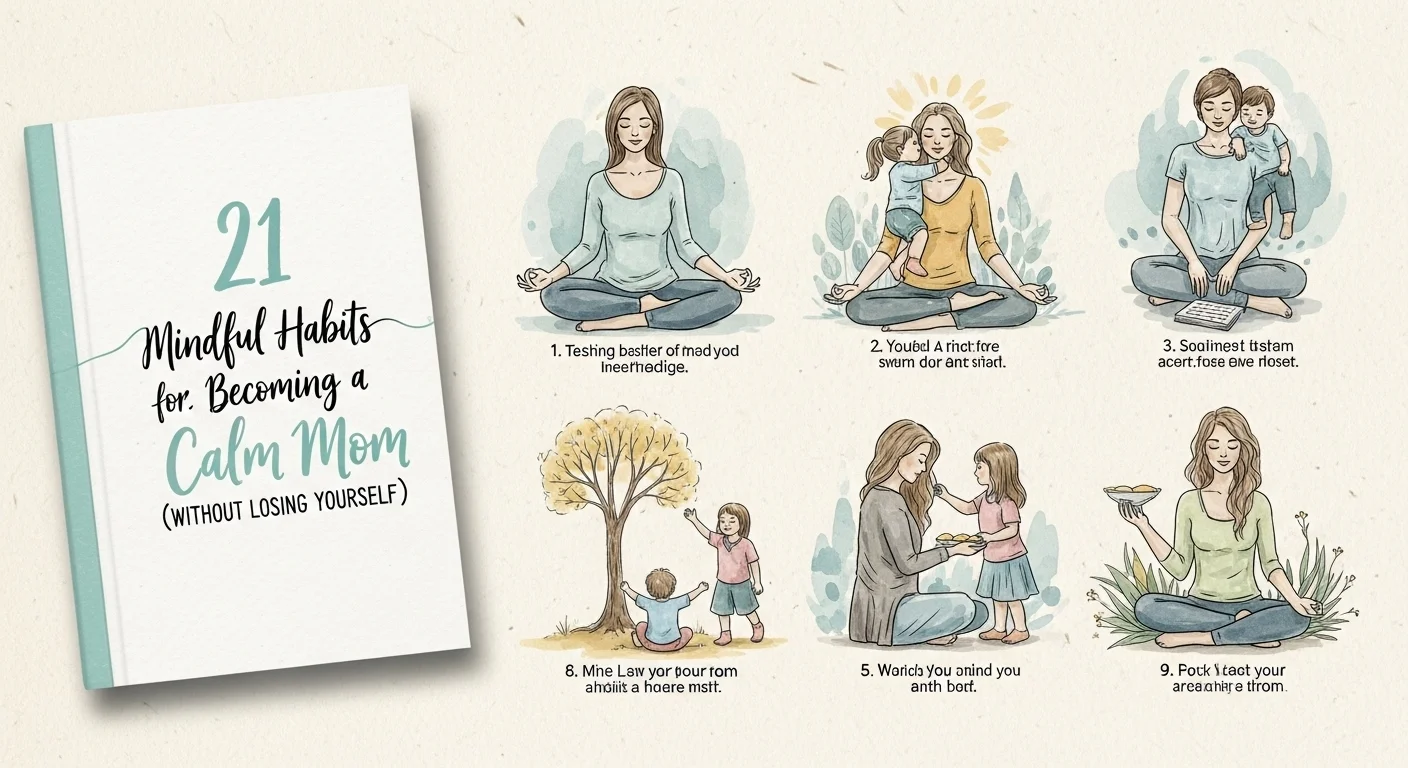27 Mindful Habits for Becoming a Calm Mom (Without Losing Yourself)
Motherhood can feel like a whirlwind—meals to prepare, tantrums to calm, laundry piles that never end. But staying calm, even when chaos takes over, is a gift both to yourself and your children. A calm mom builds connection, reduces household stress, and teaches emotional resilience by example. In a world full of pressure, finding peace in the everyday moments is what creates a lasting bond between you and your children. This guide focuses on mindful, unique practices that help you stay grounded and emotionally regulated.

There are 21 calm mom tips for you.
1. Try Mirror Breathing with Your Toddler
Sit face to face with your child and breathe in sync for 60 seconds. Not only does this calm you both, but it also teaches emotional regulation through modeling.

2. Create a 3-Minute Joy Journal
Keep a notebook in the kitchen or bedroom. Jot down 1 joyful moment from the day, no matter how small. Gratitude keeps the chaos in perspective.

3. Use Sensory Anchors
Smell is powerful. Keep a calming essential oil nearby—lavender, orange, or vanilla—and inhale it when things get heated. It instantly cues calm.

4. Go on Mini Nature Walks
Even 10 minutes outside—barefoot in grass or walking the block—can reduce cortisol levels. Nature grounds you and slows the pace of your thoughts.

5. Embrace “Let It Go” Hour
Designate one hour each day where nothing needs to be cleaned, fixed, or organized. Use that time to play, lie down, or do absolutely nothing.

6. Engage in Play for You
Build a block tower. Finger paint. Blow bubbles. You deserve joy too. Reclaim your inner child and laugh—it heals more than you realize.

7. Add Brain-Friendly Foods to Your Day
Your brain loves omega-3s, iron, and protein. Add brain foods like walnuts, berries, or spinach smoothies to your routine. A nourished mom is a calmer mom.

8. Use the 5-4-3-2-1 Reset Trick
Feel overwhelmed? Look around and name 5 things you see, 4 you can touch, 3 you hear, 2 you smell, and 1 you taste. This quick grounding method reduces anxiety.
9. Replace Yelling with Whispering
When tensions rise, lower your voice to a whisper. It’s unexpected and interrupts the chaos gently. Kids often mirror your tone.

10. Don’t Fight Every Meal Battle
Sometimes, peace means skipping the broccoli battle. Try these fun ways to get toddlers eating vegetables without turning every meal into a meltdown.
11. Try a “Mom Reset Box”
Fill a small basket with calming tools: herbal tea bags, a stress ball, affirmations, a photo that makes you smile. When you’re spiraling, open it and reset.

12. Make Space for Micro-Moments
Sip your tea without doing anything else. Watch your child sleep for one minute. These tiny pauses help regulate your nervous system.

13. Normalize Emotions Out Loud
Say “I’m feeling frustrated, so I’m going to take deep breaths.” Labeling emotions helps your kids learn healthy coping—and reminds you to practice it.

14. Create a Nightly Wind-Down Cue
Whether it’s a cup of chamomile tea, reading one page of a book, or dimming the lights—set up a signal that tells your body, “It’s safe to rest now.”

15. Try One-Minute Meditations
No time? Use an app like Insight Timer or simply sit in silence for 60 seconds. Focus on your inhale and exhale. Just one mindful minute can shift your mood.

16. Reframe Hard Moments
Instead of “Why is this happening TO me?” try “What is this teaching me?” Shifting perspective builds emotional resilience.
17. Say “Not Right Now” Without Guilt
You don’t need to do everything immediately. Teach your child patience by calmly saying, “Not right now, I’ll help you in 5 minutes.”

18. Use Humor as a Release Valve
Did your toddler just color the dog? Laugh. Take a photo. Humor can defuse tension faster than any lecture.
19. Choose a Daily Intention Word
Each morning, pick a word—“ease,” “joy,” “flow”—and remind yourself of it throughout the day. It becomes your internal compass.

20. Talk Kindly to Yourself
Would you speak to a friend the way you speak to yourself? If not, change the tone. Calm begins with self-compassion.
21. Celebrate Emotional Growth, Not Perfection
Did you pause before yelling? That’s growth. Did your toddler cry but recover quickly? That’s growth. Perfection isn’t the goal—awareness is.
22. Embrace Technology Boundaries
Silence phone notifications for an hour a day. Being unplugged helps you stay emotionally present and less reactive to outside pressures.

23. Curate a “Calm Playlist”
Create a short playlist of music that soothes your nervous system—instrumentals, soft vocals, or nature sounds. Let it play during transitions or after tantrums.

24. Start a Weekly “No Plans” Day
Choose one day a week with no obligations. Say no to playdates or errands. Let your mind and schedule breathe.

25. Try a Morning Mindful Stretch
Before reaching for your phone, stretch in bed. Roll your neck. Extend your arms. Breathe in and greet the day with calm.

26. Accept Help Without Guilt
Saying “yes” to support—whether a friend offers to babysit or your partner loads the dishwasher—doesn’t make you weak. It makes you wise.

27. Repeat a Grounding Mantra
Choose a simple phrase like, “I am safe,” or “Peace begins with me.” Repeat it slowly when you feel tension rising.
Final Thoughts
Being a calm mom doesn’t mean being passive or emotionless. It means being present, mindful, and emotionally attuned—to your needs and your child’s. You’re not alone, and you’re already doing better than you think.
Start by picking three habits from this list and try them this week. Stick the list on your fridge. Breathe, reset, and return to connection again and again.
Because when mom is calm, the whole house learns peace.







